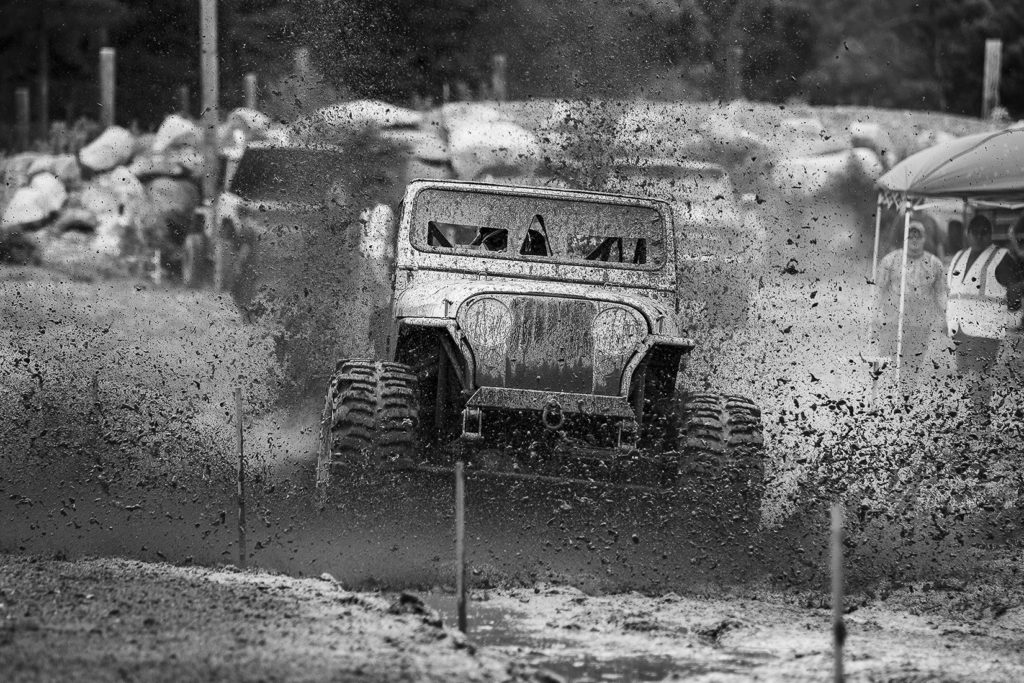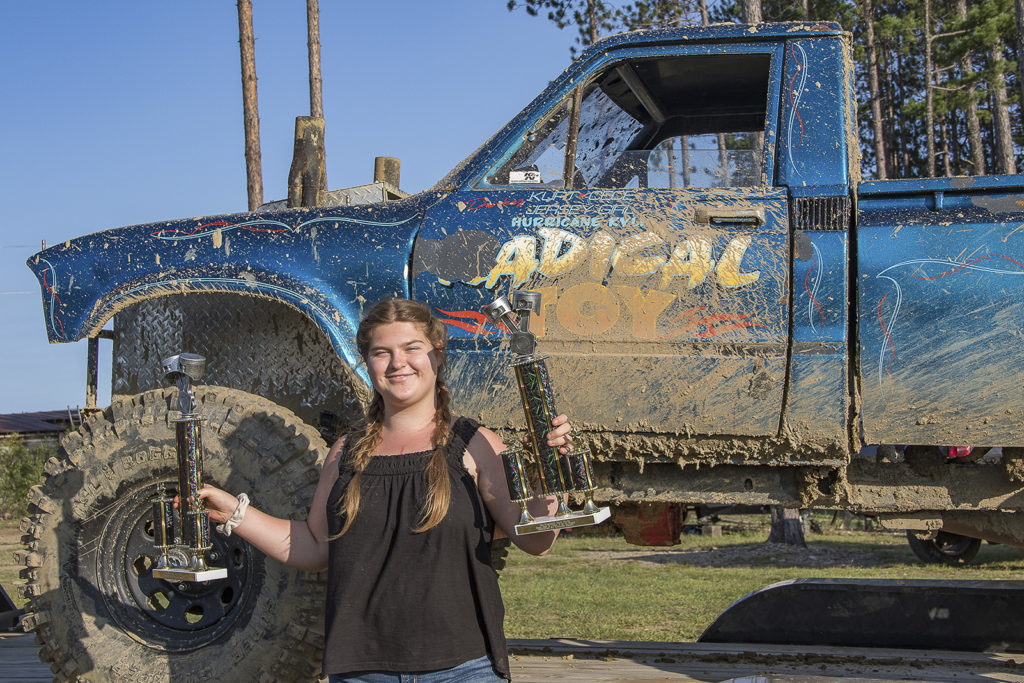The Life of a Mudding Photographer
The two-woman team behind Twisted Sprocket Studio finds beauty in mud racing.

Every June through September, photographer Brooke Adams spends one weekend a month covered in high-visibility gear and a thick layer of mud while huge rigs, frequently made of parts taken piecemeal from other vehicles (think: a Toyota Tacoma body with the engine of a Chevrolet) roar past her, sometimes mere feet away. “I’ve gotten really good at timing the wave of mud that comes when they go by,” says Adams, “so that I can duck and cover to protect my camera equipment.” For the past eight years Adams and videographer Ann Steene—the two-woman team behind Twisted Sprocket Studio—have worked as the official track photographers of Northwoods Mud Run, a four-part mudding series based in Avon, a small Franklin County town that includes part of Mount Blue State Park. In that time, they’ve mastered the art of running to get the best shot (or to get out of the way) of custom-built trucks, Jeeps, and four-wheelers blasting through dirt and mud while a packed crowd of cheering spectators looks on.
The premise of mudding, or mud racing, is relatively simple: drivers in a variety of high clearance vehicles plow through mud as quickly as they can. The types of cars, engines, and tires (or, as they say in the mudding world, “boggers”) vary, and drivers can either race the “deep mud,” slogging through a four-foot-deep mud pit, “fast track,” a timed race on a dirt track, or, for the monster trucks, the obstacle course, which involves launching off a series of jumps to try to travel the farthest, much like the long jump in track and field. Unlike many high-adrenaline sports, however, there are rarely shoe-in winners in mud racing. “It all depends on the mud,” says Kerri Phillips, who runs Northwoods with her husband, Cecil, and who has been mud racing for 30 years. Depending on the dirt-to-water ratio or the point in the day that a race takes place, the consistency of the mud may be more slick or tacky, making it either easier or harder to blast through. This in turn makes every race a toss-up, and thus all the more exciting. “You really never know who is going to win.”
This ever-changing essence of mud is what got Adams hooked on photographing it. As a child growing up in East Waterboro, she was mesmerized by the textures of the natural world that she could capture with her mother’s Polaroid. “I was always taking that camera and sneaking off into the woods to take pictures, and as I got older, any time I was out in nature I was taking stills in my mind.” That passion led her to become a fine-art photographer and an artist mentor at Spindleworks, an art center and gallery for adults with disabilities in Brunswick. It was through the Independence Association—an umbrella company of Spindleworks—that she met Steene, and the two became fast friends.
Steene grew up in a mudding family in Durham and started attending mud races when she was just two weeks old. Most summer weekends throughout her childhood were spent traveling around the state with her parents, who were part of the now-defunct Maine Mud Bogging Association. While on the circuit, they raced against and eventually became friends with the Phillipses. When Steene invited Adams (who had never heard of mudding before) to go to a race with her in 2015, something clicked. Adams borrowed a digital camera from a friend and spent the day dodging around the course, excited to have found a new subject that deepened her love for photography. After she got home and began to edit the photos, she was thrilled by the new textures to play around with. Not long after, the two approached Kerri and Cecil to volunteer their time photographing Northwoods.

Covering daylong mudding events requires a lot of stamina and courage. Wrecks are common, and visibility is typically low, especially on rainy days. Adams and Steene always wear bright pink, orange, and yellow safety gear, sturdy boots (regardless of how hot it may be) so they can break into a run at any moment, and earplugs because, as Adams says, it makes it less scary if the sound is muffled. “Brooke and I are both kind of adrenaline junkies,” says Steene. “You have to be, because who would really be crazy enough to voluntarily stand in front of these 1,000-horsepower rigs to capture them?”
For the Phillipses, mudding is a passion project. Kerri and Cecil work full-time jobs during the week, as a kindergarten teacher and carpenter, respectively, but from the moment the snow melts in the spring, all their free time is spent preparing for Northwoods. Cecil builds the tracks, obstacle courses, and mud pits with his excavator in the evenings and on weekends, and Kerri works to get sponsors for each event. Their children, Kurt, 32, and Kyli, 14, frequently help out, and of course all of them race.

The concept of a “mud family” is prevalent in the mudding community, underlining that it’s both a family sport (as indicated by the many generations that attend and participate in races) and a place to find a chosen family. Adams and Steene consider the Phillipses to be a part of their mud family and vice versa. This winter the Twisted Sprocket team reconvened with their extended mud family to cover snowmobiling events at Northwoods, which help to tide the eager racers, spectators, and, yes, photographers, over until the spring thaw. “Everybody has different jobs and comes from different walks of life, but we all come together for this one love,” says Kerri. “The love for mud.”
Read More:
- Branching Out

- 48 Hours in Cape Elizabeth, South Portland + Scarborough

- 4 Unique Winter Weekends

- Brunswick in 48 Hours




